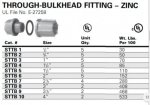Installer
Senior Member
- Location
- DesMoines, Washington
I'm working with an electrician that's an absolute perfectionist. We need to make a new run off of an existing PVC box and I want to verify that this is the best way to do it.
On the top is what we have.
On the bottom is what we would like to do.
Is this correct?
Is there a better way to do it?

Thank you in advance
On the top is what we have.
On the bottom is what we would like to do.
Is this correct?
Is there a better way to do it?

Thank you in advance




